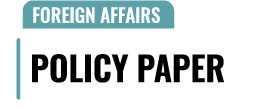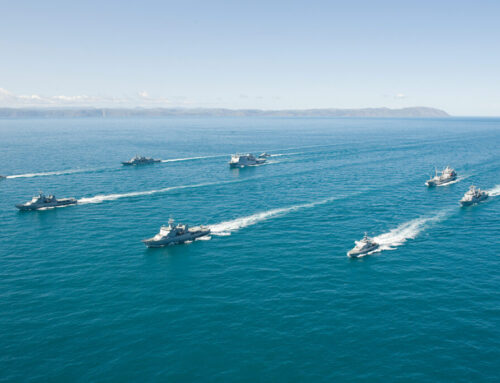PPP_FKP_JPG
Autor foto: Domena publiczna

EU global strategy: opportunities and challenges of further implementation
November 7, 2017
Author: Stanisław Koziej




PPP_FKP_JPG
Autor foto: Domena publiczna
EU global strategy: opportunities and challenges of further implementation
Author: Stanisław Koziej
Published: November 7, 2017
Pulaski Policy Paper no 3, 7 February 2017
During the meeting of the European Council on 28 June 2016, the High Representative of the European Union for Foreign Affairs, Federica Mogherini, informed the Council about the new foreign policy strategy and security policy, entitled: ‘Shared Vision, Common Action: A Stronger Europe’. The Council recommended that the High Representative, the Commission and the Council ought to take it into account in their work.
General setup
The Global Strategy of the Common Foreign and Security Policy (CFSP) presented in four chapters the EU mission in the area of security, the principles of external action, the priorities of these activities and ways to ensure their implementation. The setup of the strategy is logical: from the agenda through principles and priorities, actions to achieve them (operational strategy) to the means necessary for their realization (preparative strategy). However, the lack of in-depth evaluation and prediction regarding the security environment (conditions) of the EU in the coming years is a certain weakness here. In the current version these issues are only briefly mentioned in a half-page declarative introduction to the entire document. The most important threats have been signaled here as well as challenges and risks, such as the existential crisis inside and outside the EU questioning the European project, the violation of the European security architecture in the East, terrorism and violence in the south and in the EU itself, tensions between economic growth and demographics in Africa, tensions in Asia and climate change. It also shows the chances of global growth, mobility and technological progress. However, the document, limited to just an enumeration of risks, challenges and opportunities, is not enough to determine a realistic operational and preparative security strategy. Therefore, in the future strategic work (e.g. within the annual inspection recommended by the strategy) it would be worth considering a point for the assessment and forecasts of the European security environment.
The strategic mission of the EU in the field of security
The starting point of any strategy is to define its goals, which in the case of security strategy is to identify and define the national interest (if we are dealing with a country) or a mission statement (in the case of an international organization). It is true that the EU strategy does not use the term ‘mission’, but in fact, it is defined in the first stage, referring to the common values and interests of member states. In defining the mission of the EU, the security strategy seeks to reconcile two approaches: realism and liberalism, which are expressed in interests and values. The strategy states that: ‘Our interests and values go hand in hand. We have an interest in promoting our values in the world. At the same time, our fundamental values are embedded in our interests. Peace and security, prosperity, democracy and a rules-based global order are the vital interests underpinning our external action.’
The last decade of the EU functioning in the field of security has been a hard test of the approach to safety issues adopted in Europe. This approach, represented in particular within the European Security Strategy of 2003, was dominated by the liberal concept – the belief that values are the most important, and the Community’s action in the field of security may be built around them. Various crises and conflicts have showed that countries, when faced with a serious threat, act according to national interests. The current approach of the European strategy is therefore taking into account the lessons of recent years. With this approach, the strategic mission of the EU in the security sphere is expressed in providing its citizens and member states with conditions for the realization of their fundamental interests taking into account the most important common values. They can be generally described as additional ‘circles’ around citizens and the EU states: starting from the very vested interests, such as peace and security, through prosperity and democracy to the international order and rule of law surrounding the EU – sketch 1.
The strategy stressed that the EU would promote the peace and guarantee security of the citizens and territories of the Community. This means that Europeans, in cooperation with their partners, need to possess the ability to defend themselves, and to fulfill their commitments to mutual support and solidarity adopted in the treaties. Expanding the prosperity of the people means promoting economic growth, employment, quality of life and a safe and healthy environment. In the conditions of the digital revolution the special correlation of prosperity and a free flow of information are highlighted, and the global chain of values provided by the free and secure Internet. These include justice, solidarity, equality, non-discrimination, pluralism and respect for diversity. The strategy stresses that the EU will abide by and promote human rights, basic freedoms, and the rule of law. These include justice, solidarity, equality, non-discrimination, pluralism and respect for diversity. The strategy underlines that the EU will promote law-abiding global governance with multilateralism as the core principle and the UN as its core.
When defining the mission of the EU in matters of safety, despite the plan to combine the approach of the schools of realism and liberalism, in the content presented above regarding interest and values (security, prosperity, democracy, international order) the elements and arguments of liberal (idealistic) approach are prevailing i.e. referring to noble universal values. In terms of content it is a similar strategy to that of 2003. Therefore, perhaps it would be worthwhile to discuss a possible expansion of the EU mission description with the issues seen through the prism of national interests of the member states. It is about finding the common grounds of these interests around which the EU might organize its work in the field of security. The best would be to compare national interests of the member states from the point of view of the criterion of their acceptability by the other EU members. The common strategic denominator would consist of two packages of such interests: common ones and non-conflicting ones. While any interests of a country, which would be contrary to the national interests of any other EU country, would have to be omitted from any discussion of joint activities.
The principles of EU external action
As for the rules of operation, the strategy is looking for the golden mean, which is reflected in the so-called principled pragmatism, which the EU should use in its external relations. This means taking into account clear rules based both on realistic assessments of the environment, and idealistic aspirations to shape a better world. The EU should take the road between isolationism and interventionism, manifesting responsibility towards other countries. There are four rules of the EU’s operation in external relations: unity, commitment (activity), responsibility and partnership – sketch 2.
 The strategy emphasizes that creating unity has never been so existentially important and urgent as it is today. There is no conflict between national interests and European ones. Europe’s shared interests can be realized only by acting together. As for commitment it stresses that in an interconnected world, the EU must reach out to others, participate in the global market and shape its policies. In such conditions, there is an increasing scale of responsibility. There is no universal prescription for resolving crises, the EU, however, should rapidly prevent conflicts, to be able and ready to respond to crises, and facilitate local agreements. The EU will also strive for joint responsibility within partnership with states, with regional bodies and international organizations. It will also deepen partnerships with communities and the private sector as key actors in the networked world. There is no doubt that among these principles there is the crucial one talking about the unity of action. The idea of strategic solidarity, to be realistic, must be based on respect for national interests.
The strategy emphasizes that creating unity has never been so existentially important and urgent as it is today. There is no conflict between national interests and European ones. Europe’s shared interests can be realized only by acting together. As for commitment it stresses that in an interconnected world, the EU must reach out to others, participate in the global market and shape its policies. In such conditions, there is an increasing scale of responsibility. There is no universal prescription for resolving crises, the EU, however, should rapidly prevent conflicts, to be able and ready to respond to crises, and facilitate local agreements. The EU will also strive for joint responsibility within partnership with states, with regional bodies and international organizations. It will also deepen partnerships with communities and the private sector as key actors in the networked world. There is no doubt that among these principles there is the crucial one talking about the unity of action. The idea of strategic solidarity, to be realistic, must be based on respect for national interests.
Priorities of the EU external action
The strategy sets out five priorities for the EU: safety, resilience of countries and societies in the eastern and southern flanks, integrated approach to conflicts and crises, cooperative regional orders, and global governance for the 21st century. Europe must take more responsibility for its security and defense. A greater contribution to European security should be expressed in five types of activities: security and defense, counter-terrorism, cyber security, energy security and strategic communication (information security). In terms of collective defense NATO remains the main institution for most countries. At the same time the EU must deepen its cooperation with NATO, while maintaining the decision-making autonomy of both organizations. As for the other areas they are all significant: in the short term, counter-terrorism actions are the most urgent, in the long run – cyber security. In terms of energy security the EU could be a very effective strategic entity, but in practice, it still does not play such a role. An example here is the approach to the development of Nord Stream and the resulting risks for the eastern EU countries. In terms of information security the EU and the West are losing a confrontation with Russia in the new, hybrid Cold War. Russia has a well-developed doctrine of information security, and it implements it efficiently in practice. The EU has just begun to build a system of information security.
It is in the interest of the EU to invest in resilience i.e. a durable stability of states and societies (in the east, all the way to the Central Asia, and in the south, to the Central Africa) understood as the ability of states and societies to reform, including defeating crisis and rebuilding. Important factors enhancing the strategic resilience of the environment of the EU is the EU policy of enlargement, neighborhood and migration. It should be noted here that the strategic resilience is today becoming a particularly important category in the field of security. This is indicated by the North Atlantic Alliance in a special declaration adopted at the last summit in Warsaw.
The strategy emphasizes the need for an integrated, comprehensive approach to conflicts and crises by using all the instruments available for preventing, controlling and resolving conflicts (Fig 3).
This especially concerns the multi-phase approach, i.e. being active in all stages of the cycle of a conflict. The EU will invest in prevention, settlement and stabilization, avoiding the premature withdrawal from the operation, when a new crisis breaks out somewhere else. Considering the nature of a contemporary conflict, the EU must take into account in its strategic practice a multi-level approach, which is a willingness to be active at the local, national, regional and global levels. Finally, the EU will also take into account a multilateral approach to conflict resolution, in cooperation with all the actors.
The EU will support the building of regional systems of international order also in areas most disorganized and fragmented. It deals with the European security system (governance), the area of the Mediterranean, the Middle East and Africa, the Atlantic, Asia and the Arctic. The key elements of the European security order are sovereignty, independence and territorial integrity of states, inviolability of borders and peaceful settlement of disputes. However, peace and stability are not given once and for all. Violation of international law by Russia and destabilization of Ukraine have challenged the European security. A consistent and uniform approach must remain the cornerstone of EU policy towards Russia. Significant changes in the relations between the EU and Russia depend on the full respect of international law and the principles that constitute the European security system. In the strategy the EU declared that it would not recognize the annexation of the Crimea, nor would it accept the destabilization of eastern Ukraine. At the same time the EU and Russia are interdependent, it is assumed that there would be talks in case of misunderstandings and cooperation where interests coincide. The Mediterranean region, the Middle East and Africa are of key importance in the context of terrorist threats, demographic challenges, migration and climate change, as well as exploiting the opportunities of mutual development. The EU will invest in the future strong transatlantic relationships, including a partnership with NATO, in particular through the coordinated development of defence capabilities, parallel and synchronized exercises, mutually reinforcing action for capability building of partners outside the EU and NATO, to prevent hybrid threats and cyber threats, promoting maritime safety.
The EU is interested in effective system of global governance in the 21st century based on international law. This translates into aspiration to transform rather than the usual maintaining of the existing system. The EU will seek to reform the United Nations, including the Security Council, and to invest in UN peacekeeping missions, mediation, humanitarian aid, enlargement, universalization, full compliance with multilateral disarmament treaties and agreements on non-proliferation and arms control.
Implementation of the strategy
To achieve the objectives it is necessary to take action for the reliable, responsive and integrated EU. These requirements may be regarded as desirable characteristics of the security system, including the EU defense. It stresses that the EU must work to enhance its credibility in the field of security and defense. Member states must ensure a sufficient level of defense spending, use resources more efficiently, and achieve the common commitment to allocate 20 per cent of their defense budgets for the purchase of equipment, research and development of technology. It is important to develop military capabilities including the maximum of interoperability and the ability for joint operations so that they are available to support the EU, NATO, the UN and in other multinational tasks. To increase rapid response capabilities changes are needed in diplomacy, CSDP, development as well as investment in information and knowledge. The strategy assumes increased joined-up of external actions. This must also mean better combining of external and internal security policies and between the issues of security and development, as well as between the short term (crisis response) and long term (precautionary action to protect human rights, etc.). Finally, it points to the need for a good implementation of the established vision. This amounts to review of the existing sector strategies and preparing new strategies in terms of thematic and geographical aspects, which are consistent with the priorities of the global strategy. It is also assumed that the same Global Strategy will be a subject to periodic reviews in consultation with the Council, the Commission and the European Parliament, and its implementation evaluated in annual cycles. Depending on the needs, a new process of strategic reflection may be implemented.
Conclusions
1. During the meeting on 28 June 2016, the High Representative Federica Mogherini informed the European Council about the new foreign policy strategy and security policy of the EU. The Global Strategy (CFSP) presents in four chapters the EU mission in the area of security, the principles of external action, the priorities of these activities and ways to ensure their implementation.
2. The strategy is limited only to enumerating risks, challenges and opportunities, which is insufficient to determine a realistic operational and preparative strategy in the field of security. Therefore, in future strategic work (e.g. in the annual inspection recommended by the strategy) it would be necessary to consider adding a point for the assessment and forecasts of the European security environment.
3. Despite the plan to define the EU mission regarding security by connecting schools of realism and liberalism, according to interests-values (security, prosperity, democracy, international order), the elements and arguments of the liberal approach (idealistic) still prevail.
4. The strategy has set out five priorities for the EU: safety, the resilience of countries and societies in the eastern and southern flanks, integrated approach to the conflicts and crises, cooperative regional orders and global governance for the 21st century.
Author: Prof. Stanisław Koziej, Senior Fellow in the Peace and Stability Program at the Casimir Pulaski Foundation







